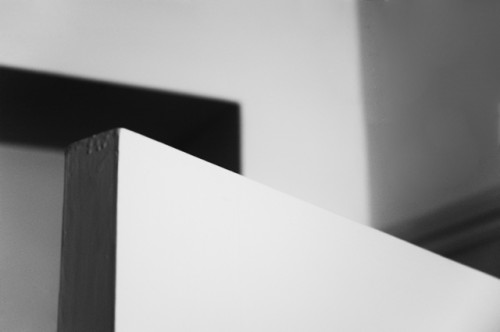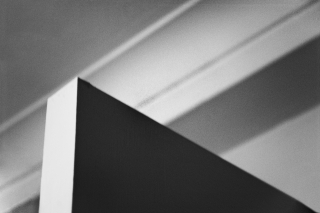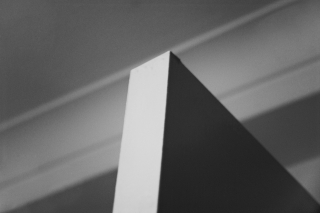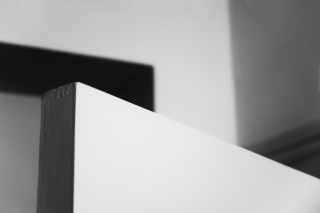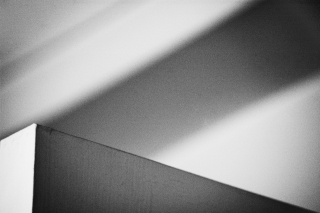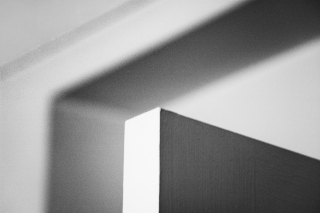In England, many doors close by itself — which sounds practical but can be annoying, as doors are slamming behind your back all the time. Which is why many people use door wedges to keep their doors open; which is what I do as well, such that I have these doors reaching into my rooms all around; which is why I have started staring at my doors when my eyes need something to hold on.
flatness & spatiality
Then, a year ago, while waking up, I saw these nice shapes made by my bedroom’s door: My camera was in reach, so I took the first picture shown here. Later looking at this picture a couple of times, I realized that I enjoyed it and wondered why. Over time I came to see it as an abstract that is formed by its very nature as a picture: Its shapes exist within the pictured plane alone, since they arise only as a projection of the foreground’s door and background’s wall. Naturally at the same time, these shapes are formed by the walls and doors in their spatiality; however, since all my doors and walls are whitish, the different shades of gray distinguishing these shapes are less a result of color but more of different amounts of light reflected depending on the objects’ angle. Thus, these shapes are formed by the flatness of the picture plane and the spatiality of the underlying objects alike. And this ambiguity caught my curiosity.
The dichotomy between flat picture and spatial content has been explored extensively, for example in Paul Strand’s photographs, such as “The White Fence”. Published in the last issue of Alfred Stieglitz’s Camera Work in 1917, this picture is pivotal to the history of photography, considered to be the first cubistic photograph at all. It is a straight shot of a juxtaposition of the ordinary, and as such, it embodies an aesthetic driven by the medium of photography, while incorporating modern developments in painting.
This dichotomy between the flat and spatial seems to be fundamental to photography and the way we compose pictures: When we arrange a scene’s elements into a composition, we look at the scene in its perceived flatness, and when we choose the elements to appear therein, we look at the scene in its spatiality. That is to say, composition combines flat arrangement with spatial choice. For example, popular principles on arrangement, such as the rules of thirds, the golden ratio, or questions on frame choice and filling, are all two-dimensional. On the other hand, common spatial principles, for example on particular viewpoints, e.g., to match the eye level, or on depth of field, or fore- and background distribution are about choosing the contents of a picture. The opposition between flatness and spatiality is also root to the categorical difference between the picture and pictured which prevails most1 photography. This difference is particularly striking, since photography is in its origin representative in establishing a mechanical link between the picture and pictured. By today, this link is highly manipulatable, but the expectations towards photography are nevertheless bound to the representative tradition. As a consequence, the picture and the pictured are opposing each other as much as they are tied together in mutual dependence.
shooting & pictures
While shooting the first picture, I was not thinking about any of this; I was day-dreaming. Later, shooting the subsequent pictures, I had flatness and spatiality in mind: I wanted to make pictures that allow for a flat and spatial reading at the same time. So I was looking for perspectives to align fore- and background lines, reduce the spatial context, form clear geometric shapes, avoid noise, and have good contrast. Alignment and reduced spatial context are most important; the alignment should create the illusion of a close relationship between fore- and background elements, and the reduced context should isolate individual lines and shapes, avoiding for example corners as they establish spatial structure.
Many words for six simple pictures — I hope they are enjoyable!
- See Chino Otsuka’s work “Imagine Finding Me” as a current example where the boundary between the picture and the pictured is blurred: She revisits scenes from childhood photographs, retakes them, and places herself as an adult next to her childhood alter ego into a combined picture. Some of Lorna Simpson’s work, currently short-listed for the Deutsche Börse Photography prize, is also breaking down the boundary between picture and pictured: In “Summer’57 / Summer ’09” Lorna Simpson reenacts pinup pictures from ’57 questioning identity and memory in producing copies that are only distinguishable by looking closely. Two popular Internet memes are also involving picture-in-picture photography: Mosaics using pictures as “pixels” and photo overlays showing an old picture of a scenery in front of the very same scenery to contrast past and present, as in Dear Photograph or in Kerényi Zoltán’s work. In these memes, although showing pictures within another picture, the boundary between the picture and pictured remains intact: The picture is re-pictured, but it does not become the pictured. ↩
